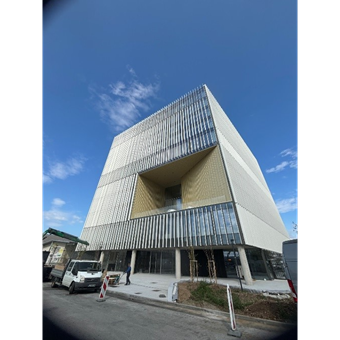On September 18th, the MESTRI team had the opportunity to visit the Montana Building, an innovative office complex in Ljubljana that is in the final stages of obtaining DGNB Gold certification. This visit provided us with invaluable insights into the holistic approach the project team used to embed sustainability into every phase of the building’s lifecycle—from initial design to post-construction performance monitoring.
A Collaborative Approach to Sustainable Design
The success of the Montana Building project was driven by the close collaboration between the investor and the key members of the design and construction team. During our visit, we were guided by the investor, architect, sustainability consultant, MEP (mechanical, electrical, and plumbing) engineer, and facility manager, who walked us through the building and explained how they addressed the stringent DGNB sustainability standards.
The team emphasized that sustainability goals were set early in the design process, with a focus on three key pillars: environmental protection, economic viability, and occupant health. This collaborative approach ensured that energy performance, material choices, and the long-term sustainability of the building were at the forefront of every decision.
Innovative Sustainable Features
One aspect of the visit was observing the sustainable technologies incorporated into the building. Some of the key features include:
· Energy-Efficient Lighting Systems: High-performance LED lighting, combined with daylight sensors and motion detectors, significantly reduces energy consumption.
· High-Performance Glazing: The windows are equipped with energy-efficient glazing, which helps regulate indoor temperatures and minimizes energy loss.
· Smart Energy Management System: A sophisticated building management system (BMS) monitors and optimizes energy usage in real-time, ensuring that resources are used efficiently and sustainably.
Balancing Sustainability with Economic Considerations
Throughout the tour, we not only discussed the technical aspects of the building’s sustainability features but also explored the economic rationale behind these investments. The investor explained how sustainable design choices, such as enhanced insulation and renewable energy systems, were expected to reduce operational costs and boost the building’s market value.
While the upfront costs of implementing sustainable solutions were around 10-15% higher, the long-term financial benefits are significant. Lower energy bills, reduced maintenance costs, and increased tenant interest due to the DGNB certification contribute to making the Montana Building a future-proof asset in a highly competitive real estate market.
Overcoming Challenges in Achieving DGNB Certification
Achieving DGNB Gold certification was not easy. The project team had to make several adjustments to the original design to comply with DGNB standards, such as upgrading the building’s thermal envelope and incorporating renewable energy sources like solar panels. The most challenging aspects were related to material sustainability and energy performance documentation, which required extensive lifecycle assessments (LCA) and environmental product declarations (EPD).
However, the team’s commitment to sustainability and their close collaboration with DGNB auditors ensured that these challenges were overcome. Their experience provides a valuable case study for other projects aiming for high levels of sustainability certification.
Looking Ahead: The Montana Building as a Model for Future Developments
The Montana Building stands as a testament to what can be achieved when sustainability is prioritized from the outset of a project. The building not only meets stringent environmental standards but also demonstrates how sustainability can be aligned with long-term economic gains.
By integrating advanced energy systems, optimizing resource use, and prioritizing occupant health and comfort, the Montana Building serves as a blueprint for future office developments. As the real estate industry moves toward more sustainable practices, projects like the Montana Building will play a crucial role in shaping the future of green architecture.
Key Takeaways
· Early Integration of Sustainability: Setting sustainability goals early in the design phase and ensuring collaboration across all disciplines is essential to achieving ambitious green building standards.
· Innovative Technologies: Smart heating and cooling, high-performance glazing, and smart energy management systems are critical to optimizing energy efficiency.
· Economic Benefits of Sustainability: Although initial costs may be higher, sustainable design choices result in reduced operational costs and increased property value in the long run.
· Challenges in Certification: Achieving DGNB Gold certification requires detailed documentation, particularly in areas like energy performance and material sustainability, but the long-term benefits make it worthwhile.
As sustainable design becomes increasingly important, the Montana Building provides a roadmap for how real estate projects can successfully balance environmental responsibility with economic viability.
